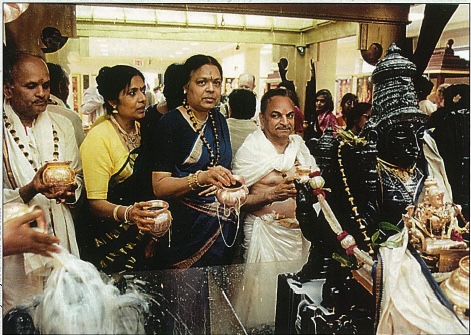By Corinne Dempsey
Nestled in a nondescript renovated barn in rural western New York State, the Hindu Goddess Rajarajeshwari is renewing the kind of religious fervor that this area was once famous for. Set into the hills of Rush, a village just south of Rochester, is the Sri Rajarajeshwari Peetham. Surrounded by farm silos and church steeples, the Peetham is headed by Sri Chaithanyananda and his wife, Sri Gnanamba, both Sri Lankan Tamils. In the early 1800s, the region was so consumed with the fire of the Spirit that it was dubbed the “Burned-over District.” But whereas then the Spirit was Christian, today the fire burns among Hindus.
Fueling the Spirit’s flames at the Peetham are the philosophies and traditions espoused by Chaithanyananda. He brings with him to Rush the ancient practice of Sri Vidya, a tradition of Devi worship which, he discovered at age 10, had been part of his family for generations before it was abandoned. In Zambia, where he worked as an architect, he found his iconoclast guru, nuclear physicist Sri Amrithananda, who not only agreed to initiate him and his wife but gave him orders, by way of guru diksa, to teach Sri Vidya to anyone desiring to learn.
The Sri Rajarajeshwari temple is an outgrowth of several home temples run by Chaithanyananda and Gnanamba, first in Zambia, and later in the US. While worshipping at their most recent home temple–a one-car garage in a suburb outside Rochester–they knew it was time to expand when approximately 150 cars lined the neighborhood streets during Navaratri. Even on ordinary days the temple was becoming crowded, and not just with humans. Chaithanyananda periodically introduced new Deities into the tiny temple, so people used to joke that if he kept this up, there would be no more room for the devotees.
Chaithanyananda conducts elaborate pujas, once in the morning and again in the afternoon and evening. Yet it is not unusual on any given day for an initiated (by Chaithanyananda) male or female to perform the rite instead. During all ritual events, initiates chant along in Sanskrit–with various levels of proficiency–and perform intricate mudras (hand and body gestures), making the event seem more like a choreographed worship-dance than the conventional solo priestly performance. During larger gatherings, all assembled are encouraged to chant the simpler, more repetitive chants. Commonly, Chaithanyananda’s voice is heard rising above the rest, admonishing meeker devotees, “Chant louder! Are you ashamed to chant the Mother’s name?!!”
Hoping to raise appreciation for religious rituals, Chaithanyananda regularly intersperses brief explanations of the rites or gives lecture-style instruction on a range of subjects. He endeavors especially to address Indian and Sri Lankan youth. “They must know what the tradition is. They must not think it is some Third World mumbo-jumbo, hocus-pocus, voodoo type thing. They must know that there is a solid foundation behind it,” he stresses.
Another unique aspect of the Peetham is the unusual layout of the building. Here the Deities are out in the open and accessible to all, eliminating the spatial divide that normally exists between the person conducting the puja and the other participants. In this environment, the congregational chanting so enthusiastically promoted by Chaithanyananda flows more freely. Charulata, an initiated woman, told me that, in other temples, “Most of the time you don’t know what is going on. You don’t understand what the pujari is saying. So you just stand there and pray and then come out. But here we are all together. He makes you say the mantra, makes you listen to what he’s saying. The Devi, Chaithanyananda and the devotees are all standing in one room.”
Commenting on the number of young and elderly devotees who are increasingly attracted to the Peetham’s open style, Chaithanyananda remarks in his irrepressible way, “Why do you think the Mother is using me? Because She likes a maverick!”
SRI RAJARAJESWARI PEETAM, 6970 EAST RIVER ROAD, RUSH, NEW YORK 14543 USA. TEL: 716.533.1216; E-MAIL:Peetam@srividya.org; www.srividya.org.


